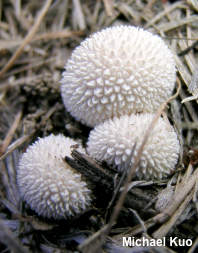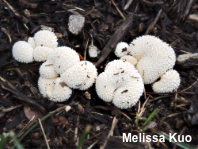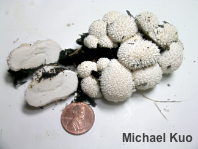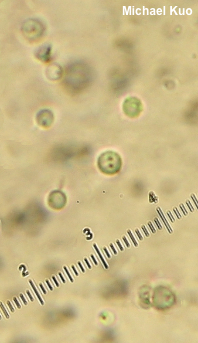| Major Groups > Puffballs > Lycoperdon curtisii |

|
Lycoperdon curtisii [ Basidiomycota > Agaricales > Agaricaceae > Lycoperdon . . . ] by Michael Kuo This tiny, spiny puffball looks as though it should be easily identified, but there are several look-alikes, including Lycoperdon pulcherrimum. Ultimately, I confirm my identifications of Lycoperdon curtisii with a microscope (see microscopic features below), but the mushroom's habit of growing in clusters in grass is a good field character. Lycoperdon curtisii usually maxes out at around 2 cm, and its long, soft spines are easily rubbed off. By maturity it often has a more or less smooth appearance, and the spines have been reduced to a whitish dust. It is shaped like a small ball, but often becomes contorted as it tries to grow should-to-shoulder with its clustered companions. Its interior is white and fleshy at first, but turns into an olive-colored dust with maturity. Lycoperdon marginatum is similar, but its outer skin flakes off in patches with maturity. Lycoperdon pulcherrimum is also similar, but usually grows in woods, and not in clusters. Vascellum curtisii and Lycoperdon wrightii are synonyms. Description: Ecology: Saprobic; usually growing in tight clusters; found in grass, often in disturbed-ground areas like ditches—but also sometimes appearing on woodchips in landscaping areas; late summer and fall; widely distributed in North America. The illustrated and described collections are from Illinois. Fruiting Body: Shaped like a small ball, 1–3 cm across, but frequently contorted as a result of clustered growth; densely spiny when young; spines 1–2 mm long, often joined at their tips, easily rubbing off; in maturity often fairly smooth, with a powdery coating; white becoming pale brownish; developing a small hole at the top, through which spore dust escapes; appearing pinched together at the bottom; with a white, fleshy interior at first; later with yellowish to olive granular flesh and eventually filled with brownish or purplish brown spore dust; base attached to white rhizoids. Microscopic Features: Spores 2–3 µm; globose; minutely echinulate; hyaline in KOH; occasionally featuring a 1–2 µm pedical. Capillitial threads 3–5 µm; wide; branching; mostly thin-walled and hyaline in KOH. REFERENCES: (Berkeley, 1859) Kreisel, 1963. (Coker & Couch, 1928; Smith, 1951; Kreisel, 1993; Barron, 1999; Roody, 2003; Calonge et al., 2004; McNeil, 2006; Miller & Miller, 2006; Cortez et al., 2013; Kuo & Methven, 2014; Jeppson, 2018.) Herb. Kuo 09210504, 10071804. This site contains no information about the edibility or toxicity of mushrooms. |
© MushroomExpert.Com |
|
Cite this page as: Kuo, M. (2019, April). Lycoperdon curtisii. Retrieved from the MushroomExpert.Com Web site: http://www.mushroomexpert.com/lycoperdon_curtisii.html |



